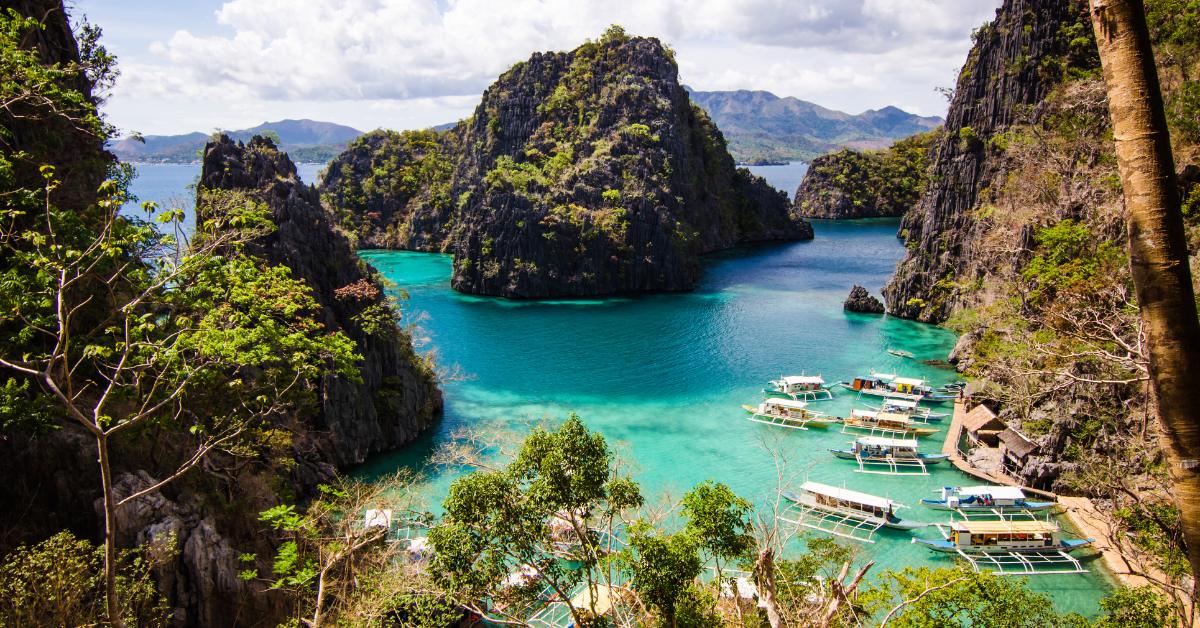The Philippines is a group of over 7000 islands which boast of beautiful beaches and excellent cities, historical places, and mountains. If you love adventure, history, or just want to get away from all, you will find something in the Philippines. In this guide, we will show you the best places in the Philippines for a holiday and where to spend your vacation in this amazing country.
10 Best Places to Visit in the Philippines
1. Palawan – A Tropical Paradise

Palawan should be number one on your list of Philippines tourist attractions if you are looking for places to visit that are beautiful and peaceful as well. This island province is famous for its clear blue waters, pristine beaches and green forests. It also contains two UNESCO World Heritage Sites, the Puerto Princesa Subterranean River and the Tubbataha Reefs Natural Park.
Must-visit spots in Palawan:
- El Nido: Famous for its dramatic limestone cliffs, lagoons, and hidden beaches, El Nido offers some of the best snorkelling and island-hopping experiences in the country.
- Coron: Known for its World War II shipwreck dives, Coron is perfect for divers and adventure enthusiasts. The lakes and pristine beaches here are equally mesmerising.
- Puerto Princesa Underground River: A must-see for nature lovers, this river flows through a limestone cave and is one of the longest navigable underground rivers in the world.
2. Boracay – The Party Island with Pristine Beaches
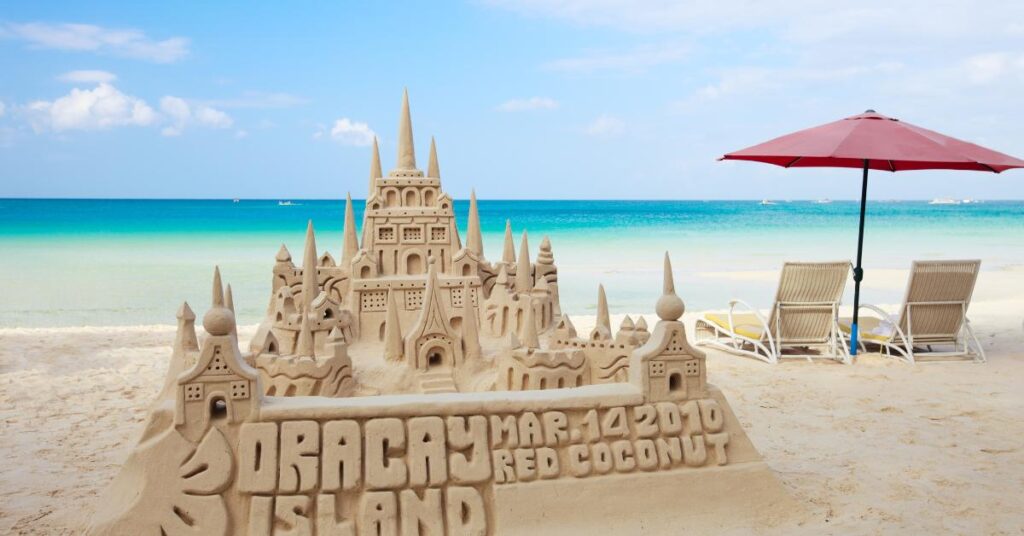
Boracay is a well-maintained tourist spot in the Philippines and with good reason. This small island has breathtaking beaches with powdery white sand and great parties. After undergoing a rehabilitation project in 2018, Boracay has restored its glory as the ideal gateway for tranquillity and entertainment.
Top things to do in Boracay:
- White Beach: The most iconic beach in Boracay, White Beach stretches over 4 kilometres and is the perfect place for sunbathing, swimming, and water sports.
- Willy’s Rock: This unique rock formation offers stunning views and is a popular photo spot.
- D’Mall: If you’re in the mood for shopping, head to D’Mall, where you can find local handicrafts, clothes, and souvenirs.
3. Cebu – The Queen City of the South
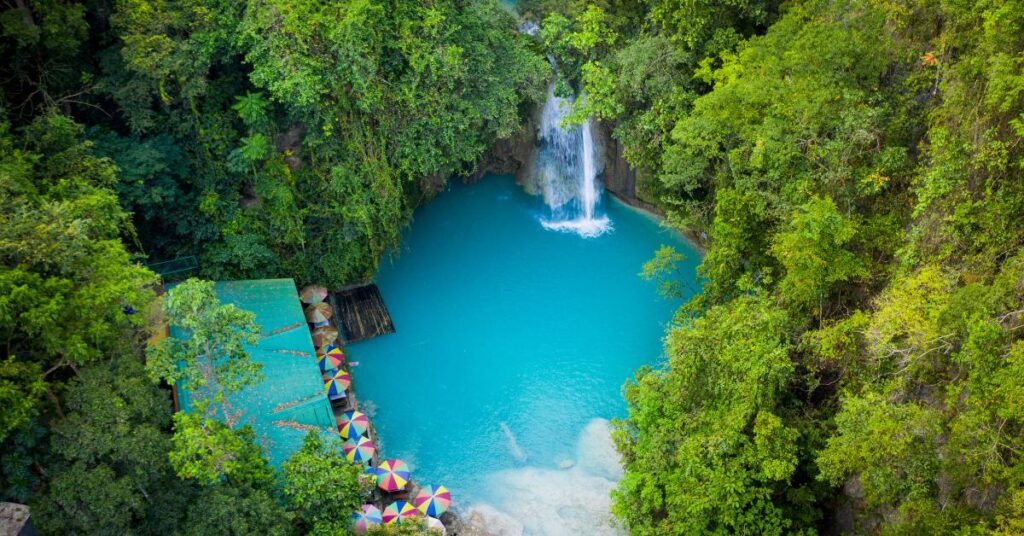
If you’re looking for a blend of history, culture, and contemporary sites, Cebu is perfect for you. Having been the very first place the Spaniards established their colony in the Philippines, it is laden with historical attractions, and it has amazing diving and snorkelling sites.
Don’t miss these Cebu tourist spots:
- Magellan’s Cross: This iconic cross marks the spot where Christianity was first introduced to the Philippines by Portuguese explorer Ferdinand Magellan in 1521.
- Kawasan Falls: A stunning multi-tiered waterfall perfect for canyoneering and a refreshing swim.
- Oslob: For an unforgettable experience, swim with whale sharks in Oslob, a once-in-a-lifetime opportunity to get up close with the ocean’s gentle giants.
4. Bohol – The Home of Chocolate Hills and Tarsiers
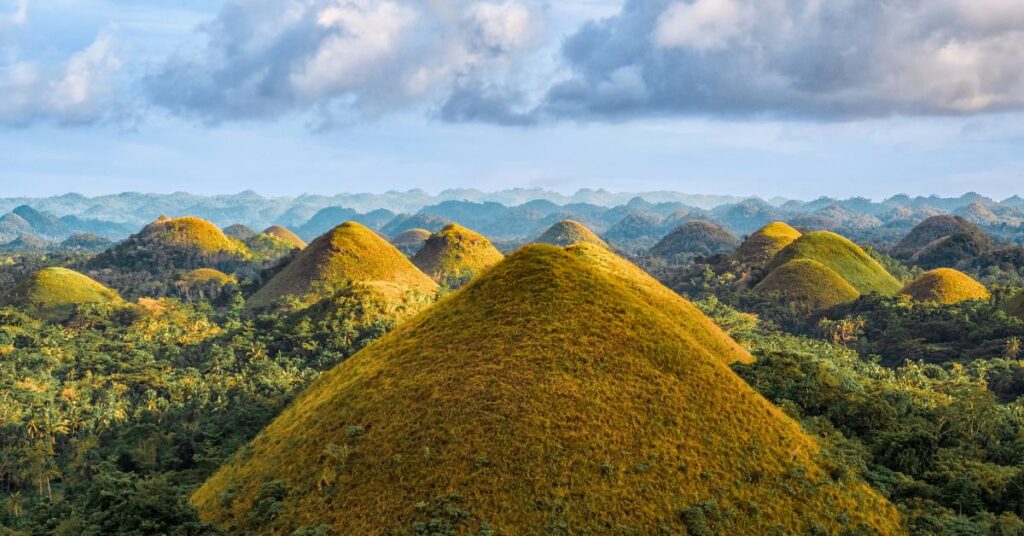
When travelling to the Philippines, do not leave out Bohol, one of its many beautiful tourist attractions. The Tarsier, known as the world’s smallest primate, can be found on this remarkable island, as well as the world-renowned Chocolate Hills.
Top attractions in Bohol:
- Chocolate Hills: These unique hills turn brown during the dry season, resembling giant chocolate mounds. The panoramic view from the viewing deck is breathtaking.
- Tarsier Sanctuary: Visit the sanctuary to see these tiny primates up close and learn about their conservation.
- Panglao Island: Known for its pristine beaches and amazing dive spots, Panglao is a must-visit for beach lovers and diving enthusiasts.
5. Batanes – A Tranquil Escape in the North
For an exclusive adventure, visit Batanes, the northernmost province of the Philippines. The sweeping hills, traditional stone huts and abundant greenery of this archipelago offer a new atmosphere ever. In case you are looking for a calm and pleasing remoteness, Batanes is one of the most beautiful tourist destinations in the Philippines.
Things to do in Batanes:
- Basco Lighthouse: Located atop a hill, this lighthouse offers stunning views of the surrounding islands and the blue ocean.
- Marlboro Hills: Known for its green hills and grazing cows, this spot offers panoramic views of Batanes’ beautiful landscape.
- Traditional Ivatan Houses: Visit the traditional stone houses of the Ivatan people, known for their unique design that protects against the strong winds in the area.
6. Siargao – The Surfing Capital of the Philippines
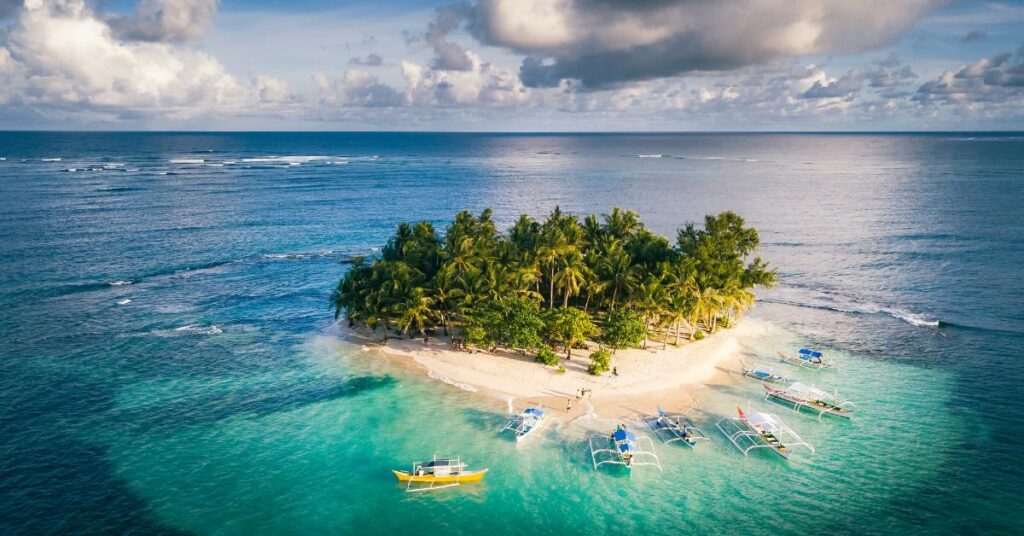
Siargao is considered a surfing mecca and the best place for tourists in the Philippines. Although this island is mainly known for its famous waves, especially Cloud 9, Siargao has more to offer other than just surfing.
Top Siargao attractions:
- Cloud 9: This world-renowned surf spot is perfect for experienced surfers, but even if you’re not into surfing, the views are spectacular.
- Sugba Lagoon: Known for its clear waters and stunning scenery, this lagoon is perfect for kayaking and paddleboarding.
- Magpupungko Rock Pools: A hidden gem where you can swim in natural rock pools during low tide, surrounded by breathtaking landscapes.
7. Vigan – A Step Back in Time
If you are in search of history and culture, Vigan in the northern part of the Philippines is one of the most beautiful places to visit in the Philippines. With its Spanish colonial structures intact, this historic town is a UNESCO World Heritage Site that gives an insight into the country’s culture and history.
Must-see spots in Vigan:
- Calle Crisologo: This cobblestone street is lined with Spanish-era buildings and is one of the best-preserved colonial streets in the Philippines.
- Vigan Cathedral: Built during the Spanish colonial period, this cathedral is an important historical and religious landmark.
- Pagburnayan Jar Factory: Visit this local pottery factory where you can see artisans create traditional clay pots using ancient techniques.
8. Tagaytay – A Relaxing Escape Near Manila
Tagaytay is one of the most ideal places to visit in the Philippines for a day trip, especially if you’re located in Metro Manila. Due to its proximity of just a couple of hours from the capital, Tagaytay is a good place to enjoy pleasant wind, spectacular countryside views, and famous local cuisine.
Top things to do in Tagaytay:
- Taal Volcano: One of the most unique volcanoes in the world, Taal sits in the middle of a lake, making it a beautiful sight to behold. You can take a boat ride to the volcano island for a closer look.
- Sky Ranch: A family-friendly amusement park with rides offering panoramic views of Taal Volcano.
- Sonya’s Garden: A peaceful and romantic retreat with beautiful gardens and homegrown food.
9. Manila – The Bustling Capital of the Philippines
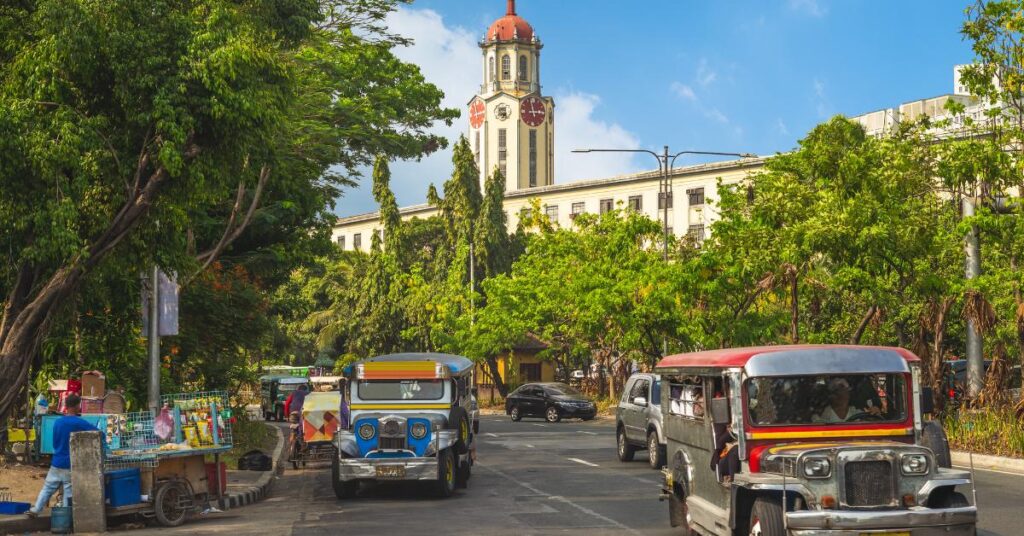
No trip to the Philippines would be complete without visiting Manila, the bustling capital city. Though known for its traffic and fast pace, Manila is home to many Philippines tourist places worth exploring, from historical landmarks to modern shopping malls.
Explore Manila’s historical landmarks:
- Intramuros: This walled city, built during the Spanish colonial period, is home to some of the most important historical sites in the country, including Fort Santiago and San Agustin Church.
- Rizal Park: Dedicated to the national hero Dr. Jose Rizal, this park is a peaceful oasis in the heart of the city.
- National Museum Complex: Learn more about Philippine history, art, and culture at the National Museum, a collection of museums that cover a wide range of topics.
10. Davao – The Land of Durian and Natural Wonders
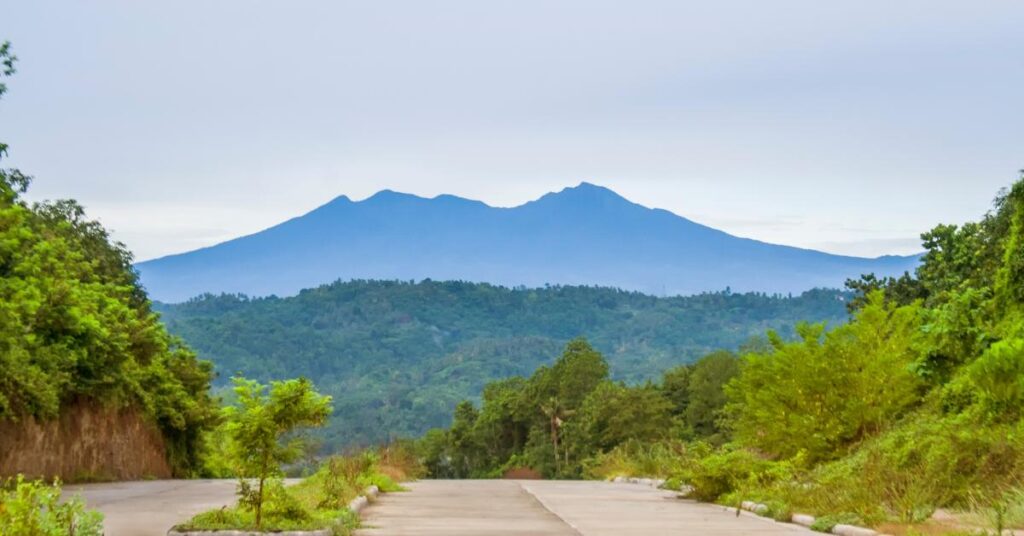
Davao is a haven for nature lovers and adventure seekers, offering everything from mountains to beaches and forests. This city in Mindanao is also famous for being home to Mount Apo, the tallest mountain in the Philippines.
Top things to do in Davao:
- Mount Apo: If you’re an avid hiker, a trek to the summit of Mount Apo is a rewarding challenge.
- Eden Nature Park: A beautiful eco-park perfect for hiking, zip-lining, and enjoying the natural scenery.
- Philippine Eagle Center: Visit this centre to learn about the conservation efforts for the critically endangered Philippine Eagle.
Travel Details for Indians Visiting the Philippines
When you are going to the Philippines for a holiday, relevant visa requirements, how much it would cost to travel, and how to get ready for such a visit are some of the travel aspects that needs to be considered. This section seeks to provide you with all the necessary information which will guide you as you travel.
1. Visa Requirements for Indians Traveling to the Philippines
Indians travelling to the Philippines for tourism need to apply for a tourist visa before arrival. The good news is that the visa process is relatively straightforward. Here’s everything you need to know about getting a Philippines visa for Indians:
Tourist Visa for Indians
- Type of Visa: The most common visa for Indian nationals is the tourist visa, which allows a stay of up to 59 days. If you intend to stay longer, you can extend your visa within the Philippines.
- Visa Application Process:
- Documents Required:
- A valid passport with at least six months of validity from your planned date of entry.
- A completed visa application form (available at the Philippine embassy or consulate).
- Passport-sized photographs.
- Proof of financial capability (such as bank statements or income tax returns).
- Round-trip flight bookings.
- Hotel bookings or a letter of invitation if you’re staying with family or friends.
- Visa fee payment (the fee may vary, usually between INR 3,000-5,000).
- Submission of Application:
- Applications can be submitted at the nearest Philippine embassy or consulate in India. You’ll need to schedule an appointment for submission.
- Processing Time:
- The processing time typically takes about 5-7 business days, but it’s a good idea to apply well in advance to avoid any delays.
- Visa Fees:
- The visa fee for a 59-day tourist visa can range from INR 3,000-5,000, depending on the embassy and the type of visa.
- Documents Required:
Visa on Arrival
- Alternative Option: The Philippines offers a Visa on Arrival (VOA) facility for Indian nationals travelling to the country for tourism purposes. You can apply for a visa upon arrival at designated international airports in the Philippines. However, this service may have certain restrictions or requirements (like proof of sufficient funds) that can change frequently, so it’s recommended to check the latest guidelines with the Philippine embassy or consulate before travelling.
2. Travel Costs and Budgeting for Your Trip to the Philippines
The cost of travelling to the Philippines can vary depending on the season, destination, and personal preferences. Here’s a breakdown of the main expenses to help you budget your trip:
Flight Costs
- Round-Trip Flight: The cost of a round-trip flight from major Indian cities (like New Delhi, Mumbai, or Bengaluru) to Manila or Cebu generally ranges between INR 25,000 and INR 40,000 for economy class. However, if you book in advance or travel during off-peak seasons, you may find cheaper flights.
- Flight Duration: A direct flight to Manila from India takes about 7-8 hours, while flights with layovers may take longer, depending on the airline and the stopover location.
Accommodation Costs
- Budget Accommodation: For budget travellers, basic guesthouses or hostels are available for as low as INR 1,000 to INR 2,500 per night.
- Mid-range Hotels: For a more comfortable stay in 3-4 star hotels, expect to pay INR 3,500 to INR 8,000 per night.
- Luxury Hotels: High-end resorts or 5-star hotels can cost anywhere between INR 10,000 to INR 20,000 per night or more, especially in tourist hotspots like Boracay or Palawan.
Food and Dining
- Street Food: The Philippines is known for its delicious and affordable street food. You can enjoy local snacks such as lumpia (spring rolls) and balut (a popular delicacy) for as little as INR 100 to INR 300.
- Mid-range Restaurants: A meal at a mid-range restaurant can cost around INR 500 to INR 1,500 per person.
- Fine Dining: In upscale restaurants, meals can cost anywhere from INR 2,000 to INR 5,000 per person, especially in cities like Manila or Cebu.
Transportation Costs
- Public Transport: Local buses, jeepneys, and tricycles are the most affordable ways to get around the cities. A ride typically costs between INR 30 and INR 100.
- Taxi: Taxis are available in most cities, and fares usually start at INR 150 to INR 250 for short distances. However, be sure to check that the taxi uses a meter to avoid overcharging.
- Inter-Island Travel: If you plan on visiting multiple islands, inter-island ferry rides are common and can cost anywhere between INR 500 and INR 2,500, depending on the distance and the ferry type.
Tourist Activities and Sightseeing
- Island-Hopping: One of the most popular activities in the Philippines is island-hopping. Depending on the destination, you can expect to pay INR 1,000 to INR 5,000 for an island-hopping tour.
- Diving and Snorkeling: For diving enthusiasts, the Philippines offers world-class diving spots. A diving session generally costs between INR 2,000 and INR 5,000, while more extensive packages can cost upwards of INR 10,000.
- Nature Parks and Historical Sites: Entry fees for museums, historical landmarks, and national parks are usually affordable, ranging from INR 100 to INR 500. Some popular spots like the Puerto Princesa Underground River may charge more.
3. Travel Insurance
While not mandatory, travel insurance is highly recommended when visiting the Philippines. A comprehensive travel insurance policy, which covers trip cancellations, lost luggage, medical emergencies, and other unforeseen events, typically costs between INR 1,500 and INR 5,000 for a short trip.
4. Best Time to Visit
The ideal time to visit the Philippines is during the dry season, which typically runs from November to April. The peak tourist season is from December to February when the weather is most pleasant. However, this is also when prices for accommodation and flights can be higher, so plan and book in advance to secure better deals.
5. Other Important Tips
- Currency: The official currency in the Philippines is the Philippine Peso (PHP). It’s a good idea to exchange your currency before travelling or upon arrival at the airport or local exchange centres.
- Language: While Filipino (Tagalog) is the national language, English is widely spoken, especially in tourist areas.
- Health Precautions: No mandatory vaccinations are required to visit the Philippines, but it’s always good to check with your healthcare provider before travelling. Don’t forget to carry sunscreen and mosquito repellent, especially when visiting tropical areas.
Conclusion: The Philippines Awaits You
With so many stunning places to visit in the Philippines, it’s no wonder that this country is becoming one of the top tourist destinations in Southeast Asia. Whether you’re drawn to its natural beauty, rich history, or vibrant culture, there’s something for everyone in the Philippines. Start planning your trip today and discover all the amazing Philippines tourist attractions that this beautiful country has to offer!
Happy travels!

